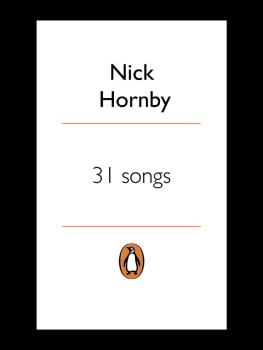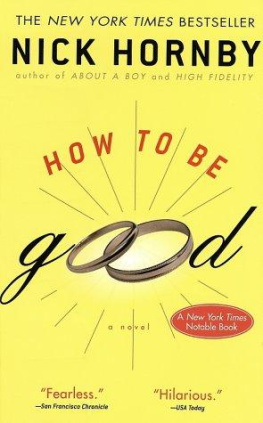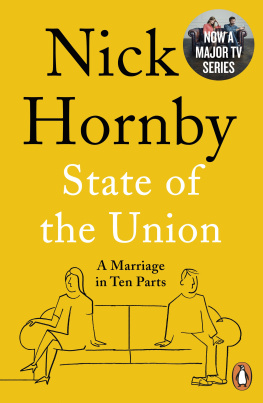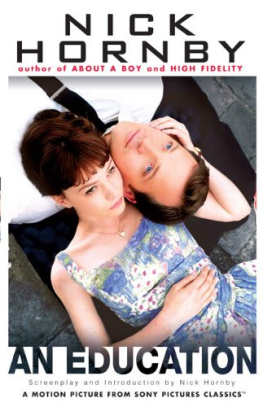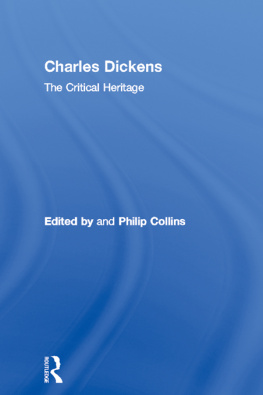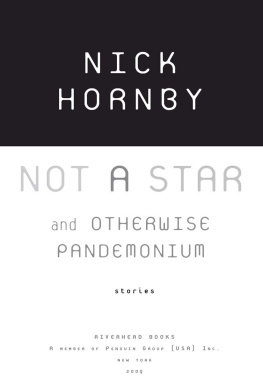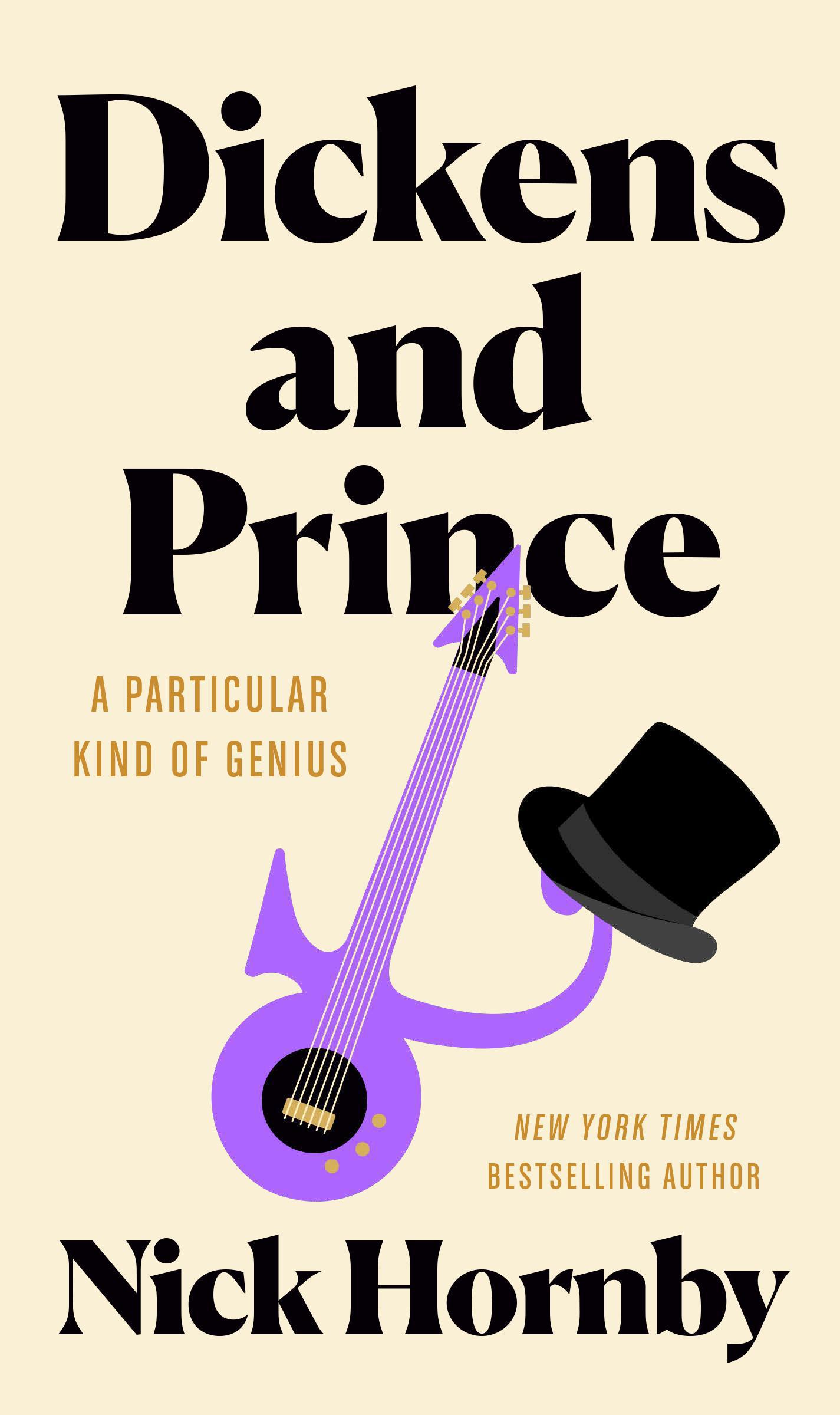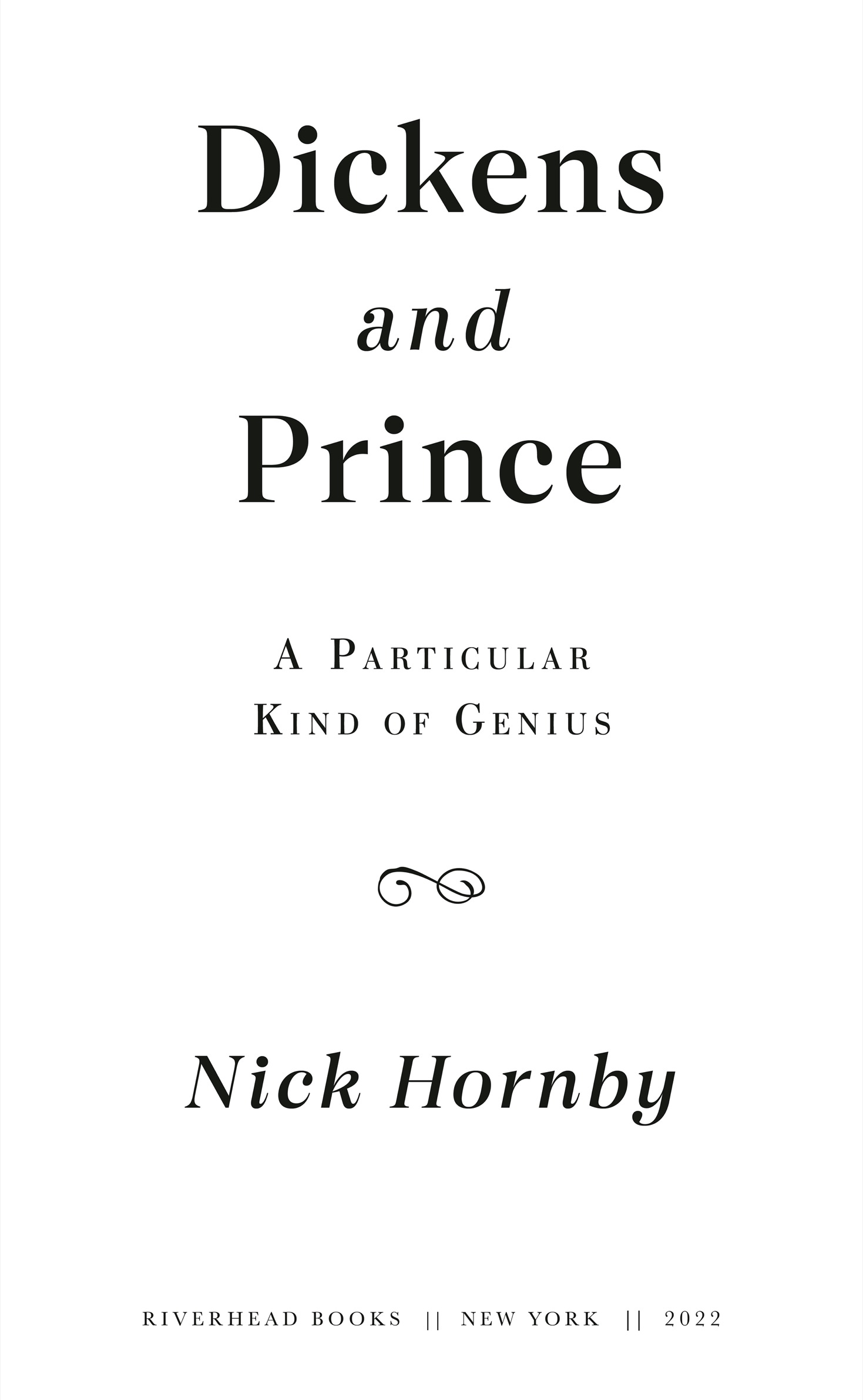Also by Nick Hornby
Fiction
Just Like You
State of the Union
Funny Girl
Juliet, Naked
Slam
A Long Way Down
How to Be Good
About a Boy
High Fidelity
Nonfiction
Shakespeare Wrote for Money
Housekeeping vs. the Dirt
The Polysyllabic Spree
Songbook
Fever Pitch
Anthology
Speaking with the Angel
Screenplay
An Education

RIVERHEAD BOOKS
An imprint of Penguin Random House LLC
penguinrandomhouse.com

First published in hardcover in Great Britain by Viking, an imprint of Penguin Random House Ltd., London, in 2022
First American edition published by Riverhead, 2022
Copyright 2022 by Nick Hornby.
Penguin Random House supports copyright. Copyright fuels creativity, encourages diverse voices, promotes free speech, and creates a vibrant culture. Thank you for buying an authorized edition of this book and for complying with copyright laws by not reproducing, scanning, or distributing any part of it in any form without permission. You are supporting writers and allowing Penguin Random House to continue to publish books for every reader.
Image credits: Daily Star/Mirrorpix cover image with photos by Max Mumbly/Getty Images, fabio formaggio/Getty Images, Stephen Frink/Getty Images, EPN/Newscom, and a photo courtesy of the Royal Society for the Prevention of Cruelty to Animals
Riverhead and the R colophon are registered trademarks of Penguin Random House LLC.
Library of Congress Cataloging-in-Publication Data
Names: Hornby, Nick, author.
Title: Dickens and Prince : a particular kind of genius / Nick Hornby.
Description: New York : Riverhead Books, 2022.
Identifiers: LCCN 2022021919 (print) | LCCN 2022021920 (ebook) | ISBN 9780593541821 (hardcover) | ISBN 9780593541838 (ebook)
Subjects: LCSH: Dickens, Charles, 1812-1870. | Prince. | Dickens, Charles, 1812-1870Appreciation. | PrinceAppreciation. | LCGFT: Biographies.
Classification: LCC PR4581 .H57 2022 (print) | LCC PR4581 (ebook) | DDC 823/.8dc23/eng/20220822
LC record available at https://lccn.loc.gov/2022021919
LC ebook record available at https://lccn.loc.gov/2022021920
Jacket design and art: Vi-An Nguyen
book design by lucia bernard, adapted for ebook by maggie hunt
pid_prh_6.0_141716077_c0_r0
To John Forrester, with thanks from everyone
He left a trail like a meteor, and everyone finds their own version... The child-victim, the irrepressibly ambitious young man... the demonic worker... The hater and lover of America. The giver of parties, the magician, the traveler... The dancer... the actor, the ham... The irreplaceable and unrepeatable... The brilliance in the room.
Claire Tomalin, Charles Dickens: A Life
Contents
Illustrations
Introduction

There used to be a thing that did the rounds, a meme before memes existed, which pointed out the uncanny similarities between Abraham Lincoln and John Fitzgerald Kennedy: both were elected to Congress in 46 and became president in 60; both were shot in the head on a Friday; both lost a son while living in the White House; both were succeeded by Southern Democrats called Johnson; both were assassinated by men with three names, each composed of fifteen letters, and so on. Well, thats not what Im going to attempt to do here. Charles John Huffman Dickens (twenty-five letters) was a white nineteenth-century writer, and Prince Nelson Rogers (eighteen letters) was a Black twentieth- and twenty-first-century musician. Dickens never heard anything that Prince recorded, and there is no evidence to suggest that Prince ever read any Dickens. I suppose one could argue feebly that they were and still are known by one name, but actually thats true of most famous artists. Yes, you have to say both Emily and Bront, because of her siblings. And you have to say Michael and Jackson, a man who famously had siblings too, but whose extraordinary fame was never quite enough to stamp ownership on his very common surname. Using both names distinguishes him from Stonewall, and Jesse, and Samuel L., and Shoeless Joe (cf. Will and Maggie Smith, Tom and January Jones, Wilkie and Phil Collins, Jimmy and Rod Stewart). The one-name thing doesnt wash. When I was thinking about linking Prince and Dickens in an extended essay, I had one coincidence to work with: they were both fifty-eight years old when they died. But dying at fifty-eight in 2016, as Prince did, is not the same as dying at fifty-eight in 1870, as Dickens did. In the early nineteenth century your average life expectancy was forty years old on the day you were born, seventyish if you lived until your fortieth birthday. And on closer inspection, Prince wasnt fifty-eight when he died. He was fifty-seven. So I dont even have that.
But heres what started it. In 2020, Princes 1987 album Sign o the Times was given the commemorative special boxed-set treatment. Usually, the rerelease of an iconic album will include anything extra that the record company can drag upsome live tracks, a few demos of the original songs, maybe a rejected song or two. Sign o the Times included sixty-three songs that werent on the original album. Sixty-three! Thats almost four times as many as the original album, three more than Jimi Hendrix released in his lifetime, two more than the Eagles recorded in the twentieth century... and they were nearly all produced around the same time. (They werent all produced for the same record, but well get to that.) The fan site PrinceVault has 102 entries in the category Songs recorded during 1986. And we are beginning to learn that 1986 was not an atypical year. When I read about the boxed set, I thought, Who else ever produced this much? Who else ever worked that way? It was supposed to be a rhetorical question, but then I realized there was an answer: Dickens. Dickens did. Dickens worked that way.
Maybe there were other people who were just as prolific, although I doubt it, especially since Prince did a lot more than just record, and Dickens did a lot more than simply write novels. But I yoked them together in my mind at that moment because they are two of what I shall have to describe, for want of a more exact term, as My Peoplethe people I have thought about a lot, over the years, the artists who have shaped me, inspired me, made me think about my own work. I have scores of people like that, influences and role models and heroes. Galton and Simpson, Donald Fagen, Preston Sturges, Barbra Streisand, Robert Altman, Pauline Kael, Kurt Vonnegut, Stephen Sondheim, Mavis Staples, Arsne Wenger, Joan Didion, Anne Tyler, Jerry Seinfeld, Rickie Lee Jones, Aretha Franklin, Thierry Henry, Elizabeth Strout, Raymond Carver, Frederick Exley, Joe Henderson, Lorrie Moore, Edward Hopper, Liam Brady, Peter Blake, Bruce Springsteen, Emmylou Harris, Duke Ellington, Elizabeth McCracken, Larry McMurtry, Roddy Doyle, Tom Verlaine, Peter Wolf, Dave Eggers, Al Green, and many, many others. I wont go into detail about what they have all meant to me: sometimes it was their taste, sometimes their thinking, or their soul, or attention to detail, or audacity, or comic timing, or arrogance, or commitment, or bravery, or the way they have lived their lives. Anyone who has spent a lifetime consuming culture in all its forms at a possibly unhealthy rate has a similar list, and if you have spent your adult life creating something during the working day, that list is likely to be even longer, because you need the input (and, lets face it, you have time that someone working on a production line or in a comprehensive school or a bank doesnt have). Prince and Dickens are two among many, but they are perhaps deserving of slightly larger type than some of the others. If anyone else did produce such a staggeringly enormous body of work, then it isnt someone I know much about. Maybe youre reading this and shouting, Wagner! Picasso! If you are, youll have to write your own book.


